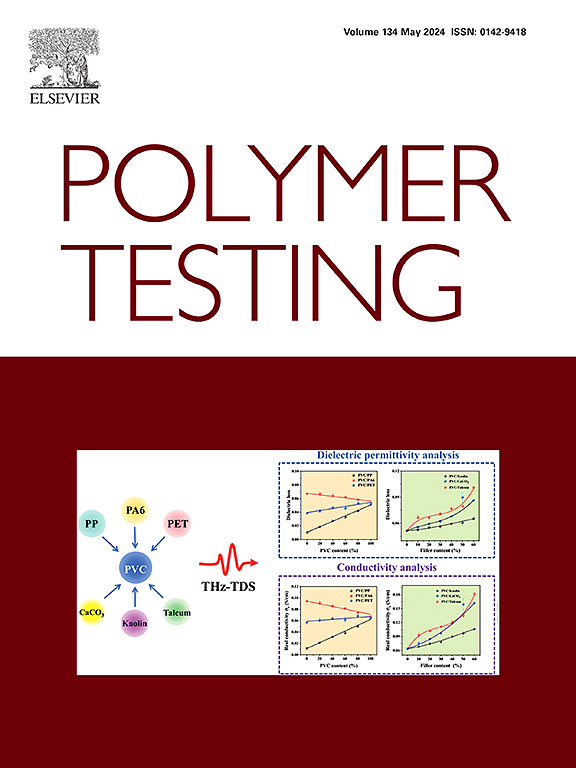Solvent-free, slow-curing, and corrosion-resistant flame retardant polyurea enabled by a Schiff base latent curing agent and phosphate polyol
IF 5
2区 材料科学
Q1 MATERIALS SCIENCE, CHARACTERIZATION & TESTING
引用次数: 0
Abstract
Polyurea (PUA) is widely recognized for its excellent waterproofing and impact resistance, making it a popular choice for protective coatings. However, its inherent flammability and rapid reaction kinetics pose significant challenges for both fire safety and processing. In this study, a Schiff base latent curing agent (D2000-MIBK) and a phosphate-containing polyol (OP550) were employed to develop a solvent-free, intrinsically flame-retardant, slow-curing PUA. The incorporation of D2000-MIBK effectively moderated the curing process, addressing the rapid reaction typical of conventional PUA systems, while OP550 significantly improved flame retardancy and mechanical performance. At just 2.22 wt%, OP550 enabled PUA-2 to achieve a UL-94 V-0 rating, demonstrating self-extinguishing behavior and reduced flaming drips. Thermogravimetric analysis confirmed that OP550 promoted char formation without altering the thermal decomposition profile of PUA, while dynamic mechanical analysis showed increased stiffness with negligible impact on the glass transition temperature. PUA-2 exhibited exceptional mechanical properties, including a tensile strength of 15.4 MPa, elongation at break of 1287.5 %, and tearing strength of 65.4 N mm−1, as well as excellent resistance to acidic, alkaline, and saline environments. Atomic force microscopy revealed optimized microphase-separated morphology, enhancing interfacial interactions and contributing to improved toughness and flexibility. This study introduces a novel strategy for developing high-performance PUA materials with superior flame retardancy, mechanical robustness, and controllable curing, offering significant potential for applications in protective coatings and structural components under demanding conditions.

无溶剂,缓慢固化,耐腐蚀阻燃聚脲,由希夫碱潜固化剂和磷酸盐多元醇实现
聚脲(PUA)因其出色的防水性和抗冲击性而广受认可,成为保护涂料的首选。然而,其固有的易燃性和快速反应动力学给消防安全和加工带来了巨大挑战。在这项研究中,我们采用了一种席夫碱潜在固化剂(D2000-MIBK)和一种含磷酸酯的多元醇(OP550)来开发一种无溶剂、本质阻燃、慢固化的 PUA。D2000-MIBK 的加入有效地缓和了固化过程,解决了传统聚氨酯体系中典型的快速反应问题,而 OP550 则显著提高了阻燃性和机械性能。OP550 的含量仅为 2.22 wt%,就使 PUA-2 达到了 UL-94 V-0 级,具有自熄性能并减少了火焰滴落。热重分析证实,OP550 可促进炭的形成,而不会改变 PUA 的热分解曲线,同时动态机械分析表明,在对玻璃化转变温度影响可忽略不计的情况下,刚度得到了提高。PUA-2 表现出优异的机械性能,包括 15.4 兆帕的拉伸强度、1287.5% 的断裂伸长率和 65.4 N mm-1 的撕裂强度,以及出色的耐酸、耐碱和耐盐碱环境性能。原子力显微镜显示了优化的微相分离形态,增强了界面相互作用,有助于提高韧性和柔韧性。这项研究提出了一种开发高性能 PUA 材料的新策略,这种材料具有优异的阻燃性、机械坚固性和可控固化性,为在苛刻条件下应用于防护涂层和结构部件提供了巨大潜力。
本文章由计算机程序翻译,如有差异,请以英文原文为准。
求助全文
约1分钟内获得全文
求助全文
来源期刊

Polymer Testing
工程技术-材料科学:表征与测试
CiteScore
10.70
自引率
5.90%
发文量
328
审稿时长
44 days
期刊介绍:
Polymer Testing focuses on the testing, analysis and characterization of polymer materials, including both synthetic and natural or biobased polymers. Novel testing methods and the testing of novel polymeric materials in bulk, solution and dispersion is covered. In addition, we welcome the submission of the testing of polymeric materials for a wide range of applications and industrial products as well as nanoscale characterization.
The scope includes but is not limited to the following main topics:
Novel testing methods and Chemical analysis
• mechanical, thermal, electrical, chemical, imaging, spectroscopy, scattering and rheology
Physical properties and behaviour of novel polymer systems
• nanoscale properties, morphology, transport properties
Degradation and recycling of polymeric materials when combined with novel testing or characterization methods
• degradation, biodegradation, ageing and fire retardancy
Modelling and Simulation work will be only considered when it is linked to new or previously published experimental results.
 求助内容:
求助内容: 应助结果提醒方式:
应助结果提醒方式:


